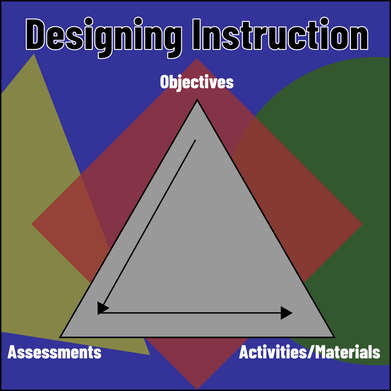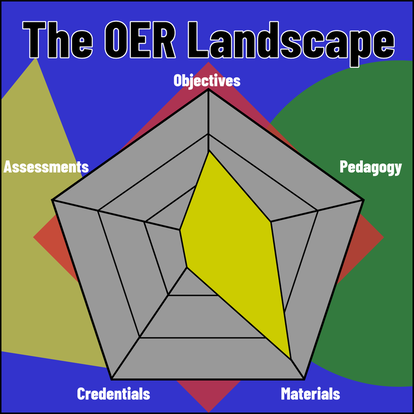|
Reading about Open Educational Resources (OER) suggests that they consist of several elements of “high-quality teaching, learning, and research materials” that are free for people everywhere to use and repurpose (Hewlett Foundation). In thinking about what these “materials” may consist of, I thought of five different resources that impact teaching, learning, and research. These 5 categories are as follows:
This list came partly from looking at the traditional process of backward design for creating instructional materials, which looks something like this. In the above image you can see that creating instructional materials usually begins with determining what it is that students need to learn. Next, instructors must determine how reaching the learning objectives will be measured. This step is completed through creating assessments that measure mastery of the learning outcome. Lastly, instructors create the materials and uses of those materials that will help learners perform well on the assessments. For the sake of OER, I have divided materials and pedagogy into two different categories. I also added the category of credentials because it is important to have a way to signify that learners have met the requirements of a learning objective. In traditional non-open educational avenues these credentials are usually diplomas, degrees, and certificates. I wonder if there is an open equivalent (maybe badges?) to these credentials. From looking at readings and definitions about OER it seems that the OER landscape is mostly made up of open materials. Here is what the landscape seems to look like to me. Here are some of the ideas from Hewlett’s definition of OER that led me to this view.
Despite Hewlett’s diverse view of OER, it seems like the research that focuses on OER (based on a sample taken from section 5 of the readings available at https://openeducation.us/2018/course-readings/) mostly focuses on textbooks and content resources. This research makes it seem as though, at least in the literature, the field of OER is focused more heavily on creating materials than it is on developing objectives, assessments, credentials, or pedagogy. I expect that objectives, assessments, credentials, and pedagogy may (out of necessity?) be included as part of some open content materials, but they do not seem to be developed and made available separately.
0 Comments
So after two weeks talking about CC licenses that do not allow derivatives, I’m still confused. I even read the CC ND license information, both the for humans and for lawyers part, it did not clarify a lot. So I decided to make a game called “Is It Derivative.” To play with my class. I know the answers to some of these, and others I have no clue on. So I want to get their opinions. I plan to update this blog once I know all of the correct answers.
To play the game, one must pretend that all of the images or text on the left are licensed with a CC ND license, then decide if the creation on the right can be legally shared with others or must remain part of a private collection. Here are the slides for the game. Note: I do not have rights to any of the images used in the slides, except for the “Is It Derivative” logo, which I might not be able to claim rights to anyway, due to maybe being derivative. https://docs.google.com/presentation/d/1FP6XLAu7tKv95iA5m1ixRxwCnPmedOC2EOBac3Yk4tg/edit?usp=sharing |
About
This blog presents thoughts that Cecil has concerning current projects, as well as musings that he wants to get out for future projects. For questions or comments on his posts, please go to his Contact page. Archives
April 2024
Tags
All
|


 RSS Feed
RSS Feed
